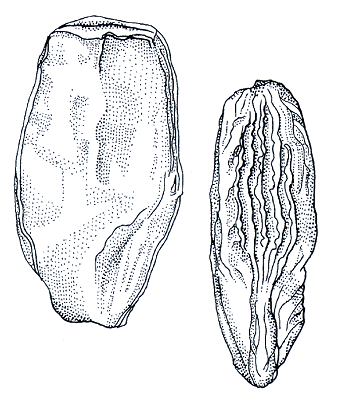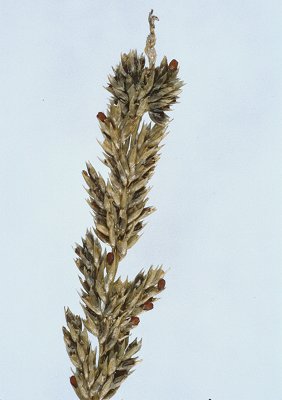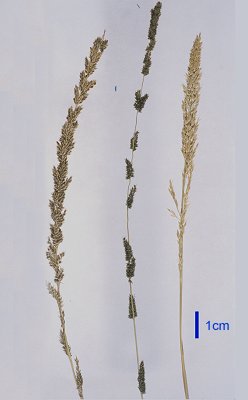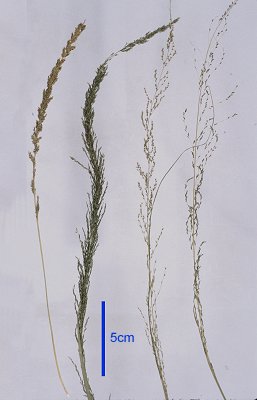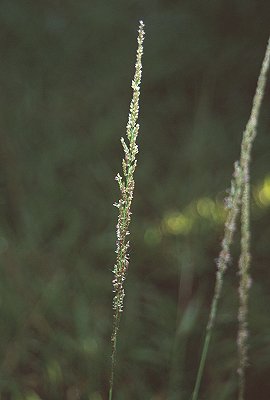Sporobolus africanus* (Poir.) Robyns
& Tournay. Bull. Jard. Bot. Brux.
25: 242 (1955).
Classification. (GPWG 2001) : Subfamily Chloridoideae. Cynodonteae.
Basionym and/or
Replacement Name: Agrostis
africana Poir., Encycl., Suppl. 1: 254 (1810).
Type of Basionym or
Protologue Information: HT: Thunberg s.n., South Africa: Cape
Province (UPS).
Recent synonyms:
S. capensis, S. indicus var. africanus, S. indicus var. capensis.
Key references
(books and floras): [1810]. R.Brown, Prodromus (170), [1952]
C.A.Gardner, Flora of Western Australia 1 Gramineae (162 as S.
capensis), [2002] D.Sharp & B.K.Simon, AusGrass, Grasses of
Australia, [2002] J.Wheeler, N.Marchant & M.Lewington, Flora of the
South West (436), [2006] J.Jessop, G.R.M.Dashorst, F.M.James, Grasses of
South Australia (396), [2008] S.W.L.Jacobs, R.D.B.Walley &
D.J.B.Wheeler, Grasses of New South Wales (376).
Illustrations:
[1952] C.A.Gardner, Flora of Western Australia 1 Gramineae (161,
Pl.48 as S. capensis), [1984] N.T.Burbidge. rev. S.W.L.Jacobs, Australian
Grasses (247), [2006] J.Jessop,
G.R.M.Dashorst, F.M.James, Grasses of South Australia (397, fig. 328), [2008] S.W.L.Jacobs,
R.D.B.Whalley & D.J.B.Wheeler, Grasses of New South Wales, 4th edn
(376).
Habit.
Perennial. Culms erect, 15–110 cm tall, 1.5–3 mm diam. Lateral branches
branched. Ligule a fringed membrane or a fringe of hairs, 0.3 mm long. Leaf-blades
linear, flat or involute or convolute, 6–40 cm long, 1–4 mm wide.
Inflorescence.
Inflorescence solid, a panicle. Panicle linear, 6–35 cm long, contracted about
primary branches.
Spikelets.
Spikelets sessile or pedicelled. Fertile spikelets 1-flowered, comprising 1
fertile floret(s), without rachilla extension, lanceolate, terete,
(1.5–)2.1–2.8 mm long.
Glumes. Glumes
dissimilar. Lower glume lanceolate or elliptic or oblong, hyaline, without
keels, 0–1 -nerved. Upper glume lanceolate or ovate, 1–1.5 mm long, membranous,
without keels, 1 -nerved.
Florets.
Fertile lemma (1.5–)2.1–2.8 mm long, without keel, 1 -nerved. Palea 2 -nerved.
Palea apex entire. Anthers 3. Grain 1.1–1.3 mm long.
Continental
Distribution: Africa, Temperate Asia, Tropical Asia, Australasia, and
Pacific.
Australian
Distribution: Western Australia, Northern Territory, South Australia,
Queensland, New South Wales, Victoria, Tasmania, Norfolk I, Lord Howe.
Western Australia:
Drummond, Dale, Warren, Eyre. Northern Territory: Central Australia
North, Central Australia South. South Australia: Murray, Southern Lofty,
Kangaroo Island, South-eastern. Queensland: Cook, Darling Downs,
Moreton, Wide Bay, Burke, Burnett. New South Wales: North Coast, Central
Coast, South Coast, Northern Tablelands, Central Tablelands, Southern
Tablelands, South-Western Plains. Victoria: East Gippsland, Eastern
Highlands, Gippsland Plain, Midlands, Otway Plain, Otway Range, Riverina,
Volcanic Plain, Wannon. Tasmania: Furneaux Group, North West, North
East, Midlands, East Coast.
Notes.
Differs from S. indicus by its narrow, denser inflorescence and larger
spikelets. S. africanus also differs from S. fertilis by larger
spikelets and by the inflorescence branches being more appressed at the base.
Introduced;
mainly coastal distribution from Brisbane, Qld to Adelaide, S.A.. Also in Tas.
and coastal areas around Perth, W.A.; New Zealand, southern Africa, and the
Pacific region. Of African origin, is weedy in Australia, growing in lawns,
sports grounds and along roadsides and forms wiry tufts when mown. Widespread
in stressed areas of farms (yards, gateways etc). It poses a minor problem to
pastoralists in subtropical coastal eastern Australia; flowers all year, but
mostly spring to autumn.


